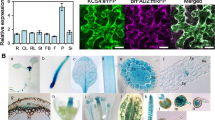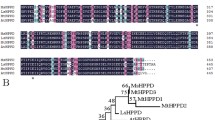Abstract
N-Acylethanolamines (NAEs) are prevalent in desiccated seeds of various plant species, and their levels decline substantially during seed imbibition and germination. Here, seeds of Arabidopsis thaliana (L.) Heynh. were germinated in, and seedlings maintained on, micromolar concentrations of N-lauroylethanolamine (NAE 12:0). NAE 12:0 inhibited root elongation, increased radial swelling of root tips, and reduced root hair numbers in a highly selective and concentration-dependent manner. These effects were reversible when seedlings were transferred to NAE-free medium. Older seedlings (14 days old) acclimated to exogenous NAE by increased formation of lateral roots, and generally, these lateral roots did not exhibit the severe symptoms observed in primary roots. Cells of NAE-treated primary roots were swollen and irregular in shape, and in many cases showed evidence, at the light- and electron-microscope levels, of improper cell wall formation. Microtubule arrangement was disrupted in severely distorted cells close to the root tip, and endoplasmic reticulum (ER)-localized green fluorescent protein (mGFP5-ER) was more abundant, aggregated and distributed differently in NAE-treated root cells, suggesting disruption of proper cell division, endomembrane organization and vesicle trafficking. These results suggest that NAE 12:0 likely influences normal cell expansion in roots by interfering with intracellular membrane trafficking to and/or from the cell surface. The rapid metabolism of NAEs during seed imbibition/germination may be a mechanism to remove this endogenous class of lipid mediators to allow for synchronized membrane reorganization associated with cell expansion.








Similar content being viewed by others
Abbreviations
- ER:
-
Endoplasmic reticulum
- DMSO:
-
dimethyl sulfoxide
- GFP:
-
green fluorescent protein
- LA:
-
lauric acid
- NAE:
-
N-acylethanolamine
- NAPE:
-
N-acylphosphatidylethanolamine
- PLD:
-
phospholipase D
- numerical designation for acyl groups, number of carbons in acyl chain::
-
number of double bonds in acyl chain
References
Assaad FF, Huet Y, Mayer U, Jurgens G (2001) The cytokinesis gene KEULE encodes a Sec1 protein that binds the syntaxin KNOLLE. J Cell Biol 152:531–543
Austin-Brown S, Chapman KD (2002) Inhibition of phospholipase Dα by N-acylethanolamines. Plant Physiol 129:1892–1898
Barlow PW, Baluska F (2000) Cytoskeletal perspectives on root growth and morphogenesis. Annu Rev Plant Physiol Plant Mol Biol 51:289–322
Baskin TI, Bivens NJ (1995) Stimulation of radial expansion in Arabidopsis roots by inhibitors of actomyosin and vesicle secretion but not by various inhibitors of metabolism. Planta 197:514–521
Baskin TI, Wilson JE, Cork A, Williamson RE (1994) Morphology and microtubule organization in Arabidopsis roots exposed to oryzalin or taxol. Plant Cell Physiol 35:935–942
Benfey PN, Scheres B (2000) Root development. Curr Biol 16:R813–R815
Berdyshev EV (2000) Cannabinoid receptors and the regulation of immune response. Chem Phys Lipids 108:169–190
Bibikova TN, Blancaflor EB, Gilroy S (1999) Microtubules regulate tip growth and orientation in root hairs of Arabidospis thaliana. Plant J 17:657–665
Blancaflor EB, Hasenstein KH (1995) Growth and microtubule orientation of maize roots subjected to osmotic stress. Int J Plant Sci 156:794–802
Blancaflor EB, Jones DL, Gilroy S (1998) Alterations in the cytoskeleton accompany aluminum induced growth inhibition and morphological changes in primary roots of Zea mays L. Plant Physiol 118:159–172
Chapman KD (1998) Phospholipase activity during plant growth and development and in response to environmental stress. Trends Plant Sci 3: 419–426
Chapman KD (2000) Emerging physiological roles for N-acylphosphatidylethanolamine metabolism in plants: signal transduction and membrane protection. Chem Phys Lipids 108:221–230
Chapman KD, Sprinkle WB (1996) Development, tissue-specific and environmental factors regulate the biosynthesis of N-acylphosphatidylethanolamine in cotton (Gossypium hirsutum L.). J Plant Physiol 149:277–284
Chapman KD, Sriparameswaran A (1997) Intracellular localization of N-acylphosphatidylethanolamine synthesis in cotyledons of cotton seedlings. Plant Cell Physiol 38:1359–1367
Chapman KD, Tripathy S, Venables B, Desouza A (1998) N-acylethanolamines: formation and molecular composition of a new class of plant lipids. Plant Physiol 116:1163–1168
Chapman KD, Venables B, Blair R Jr, Bettinger C (1999) N-acylphosphatidylethanolamines in seeds: quantification of molecular species and their degradation upon imbibition. Plant Physiol 120:1157–1164
Cockcroft S (2001) Signaling roles of mammalian phospholipase D1 and D2. Cell Mol Life Sci 58:1674–1687
Cosgrove DJ (2000) Expansive growth of plant cells. Plant Physiol Biochem 38:109–124
De Petrocellis L, Melck D, Bisogno T, Di Marzo V (2000) Endocannabinoids and fatty acid amides in cancer inflammation and related disorders. Chem Phys Lipids 108:191–209
Di Marzo V (1998) Endocannabinoids and other fatty acid derivatives with cannabimimetic properties: biochemistry and possible physiological relevance. Biochim Biophys Acta 1392:153–175
Dolan L, Janmaat K, Willemsen V, Linstead P, Poethig S, Roberts K, Scheres B (1993) Cellular organization of the Arabidopsis thaliana root. Development 119:71–84
Esau K (1977) Anatomy of seed plants. Wiley, New York
Gardiner JC, Harper JDI, Weerakoon ND, Collings DA, Ritchie S, Gilroy S, Cyr RJ, Marc J (2001) A 90-kD phospholipase D from tobacco binds to microtubules and the plasma membrane. Plant Cell 13:2143–2158
Granger CL, Cyr RJ (2001) Spatiotemporal relationships between growth and microtubule orientation as revealed in living root cells of Arabidopsis thaliana transformed with the green-fluorescent protein gene construct GFP-MBD. Protoplasma 216:201–214
Hansen HS, Moesgaard B, Hansen HH, Petersen G (2000) N-Acylethanolamines and precursor phospholipids—relation to cell injury. Chem Phys Lipids 108:135–150
Harper JDI, Holdaway NJ, Brecknock SL, Busby CH, Overall RL (1996) A simple and rapid technique for the immunofluorescence confocal microscopy of intact Arabidopsis root tips. Cytobios 87:71–78
Haseloff J, Siemering KR (1998) The uses of GFP in plants. In: Chalfie M, Kain S (eds) Green fluorescent protein: strategies, applications and protocols. Wiley, New York, pp 191–220
Hawes CR, Brandizzi F, Andreeva AV (1999) Endomembranes and vesicle trafficking. Trends Plant Sci 2:454–461
Hawes CR, Saint-Jore C, Martin B, Zheng H-Q (2001) ER confirmed as the location of mystery organelles in Arabidopsis plants expressing GFP. Trends Plant Sci 6:245–246
Hepler PK, Vidali L, Cheung AY (2001) Polarized cell growth in higher plants. Annu Rev Cell Dev Biol 17:159–187
Howlett AC, Mukhopadhyay S (2000) Cellular signal transduction by anandamide and 2-arachidonylglycerol. Chem Phys Lipids 108:53–70
Legue V, Blancaflor E, Wymer C, Perbal G, Fantin D, Gilroy S (1997) Cytosolic free calcium in Arabidospis roots changes in response to touch but not gravity. Plant Physiol 114:789–800
Munnik T, Musgrave A (2001) Phospholipid signaling in plants: holding on to phospholipase D. Science's STKE http://stke.sciencemag.org/cgi/content/full/sigtrans;2001/111/pe42
Otegui M, Staehelin LA (2000) Cytokinesis in flowering plants: more than one way to divide. Curr Opin Plant Biol 3:493–502
Paria BC, Dey SK (2000) Ligand-receptor signaling with endocannabinoids in preimplantation embryo development and implantation. Chem Phys Lipids 108:211–220
Pertwee RG (1997) Pharmacology of cannabinoid CB1 and CB2 receptors. Pharmacol Ther 74:129–180
Reggio PH, Traore H (2000) Conformational requirements for endocannabinoid interaction with the cannabinoid receptors, the anandamide transporter, and fatty acid amidohydrolase. Chem Phys Lipids 108:15–36
Sandoval JA, Huang Z-H, Garret DC, Gage DA, Chapman KD (1995) N-Acylphosphatidylethanolamine in dry and imbibing cotton (Gossypium hirsutum L.) seeds: amounts, molecular species and enzymatic synthesis. Plant Physiol 109:269–275
Sang Y, Zheng S, Li W, Huang B, Wang X (2001) Regulation of plant water loss by manipulating the expression of phospholipase Dα. Plant J 28:1-11
Schiefelbein JW, Masucci JD, Wang H (1997) Building a root: the control of patterning and morphogenesis during root development. Plant Cell 9:1089–1098
Schmid HH, Schmid PC, Natarajan V (1996) The N-acylation-phosphodiesterase pathway and cell signaling. Chem Phys Lipids 80:133–142
Shrestha R, Noordimeer M, van der Stelt M, Veldink G, Chapman KD (2002) N-Acylethanolamines are metabolized by lipoxygenase and amidohydrolase in two competing pathways during cotton (Gossypium hirsutum L) seed imbibition. Plant Physiol 130:391–401
Steinborn K, Maulbetsch C, Priester B, Trautmann S, Pacher T, Geiges B, Kuttner F, Lepiniec L, Stierhof Y-D, Scharwz H, Jurgens G, Mayer U (2002) The Arabidopsis PILZ group genes encode tubulin-folding cofactor orthologs required for cell division but not cell growth. Genes Dev 16:959–971
Tripathy S, Venables BJ, Chapman KD (1999) N-acylethanolamines in signal transduction of elicitor perception: attenuation of alkalinization response and activation of defense gene expression. Plant Physiol 121:1299–1308
Waizenegger I, Lukowitz W, Assaad F, Schwarz H, Jǜrgens G, Mayer U (2000) The Arabidopsis KNOLLE and KEULE genes interact to promote vesicle fusion during cytokinesis. Curr Biol 10:1371–1374
Wilson RI, Nicoll RA (2002) Endocannabinoid signaling in the brain. Science 296:678–682
Acknowledgments
Financial support for this work was provided in part by USDA-NRICGP agreement number 99-35304-8002 to K.D.C., NASA grant number NAG 2-1518 to E.B.B. and the Samuel Roberts Noble Foundation. We thank the Arabidopsis stock center (Ohio State University) for the root expressing mGFP5-ER seeds and Dr. Richard A. Dixon, Samuel R. Noble Foundation, for critical reading of the manuscript. We also thank Mr. David Garret, University of North Texas, for assistance with transmission electron microscopy.
Author information
Authors and Affiliations
Corresponding author
Rights and permissions
About this article
Cite this article
Blancaflor, E.B., Hou, G. & Chapman, K.D. Elevated levels of N-lauroylethanolamine, an endogenous constituent of desiccated seeds, disrupt normal root development in Arabidopsis thaliana seedlings. Planta 217, 206–217 (2003). https://doi.org/10.1007/s00425-003-0985-8
Received:
Accepted:
Published:
Issue Date:
DOI: https://doi.org/10.1007/s00425-003-0985-8




